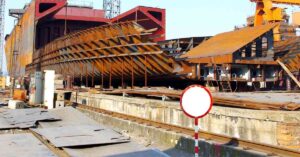

Ship terms related to the nautical industry are often misunderstood by the people outside of the industry and those who are part of it. Such misunderstanding of terms or definitions can lead to confusion among people, resulting in accident, loss or sheer embarrassment.
A number of these ship terms are very commonly used and spoken of; however, the fact remains that the true meaning of a number of them is still not fully understood by even the smartest people.
Let’s look at some of the most commonly misused and misunderstood ship terms and definitions. (Please do note that this is not an exhaustive list of misunderstood words used on ships, but the important ones, we felt, need to be addressed.)
These ship terms might not be very famous among people outside the industry but are well known among maritime professionals.
The key difference between these two doors on ships is the location of their siting.
Weathertight Doors are primarily located above the waterline of the vessel. They are designed to prevent the ingress of water from outside to inside. This generally includes a small head of water. Their main use is to prevent the ingress of green seas into the space of the ship they are designed to protect. Most of the doors on deck/accommodation on tanker ships are weathertight doors. These doors are designed to open outwards, thereby ensuring a positive pressure should a draught of water act on them.
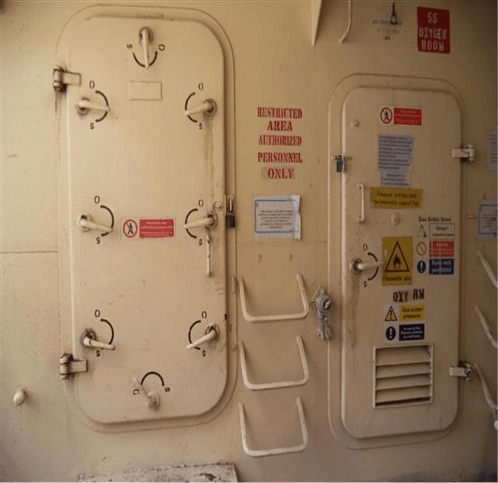

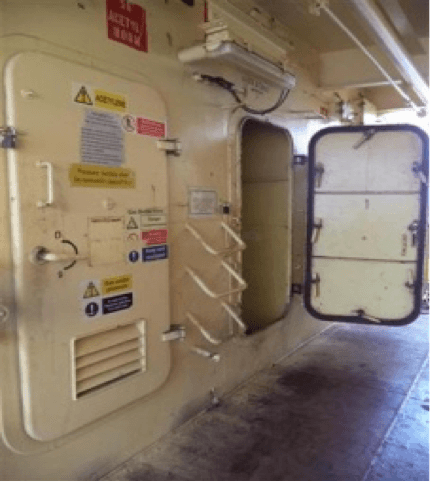

On the other hand, watertight doors are designed to prevent water ingress from both sides, thereby ensuring that the watertight integrity of the neighbouring compartment of the ship is not lost. Watertight doors are located below deck level and are designed to open and close upwards or sidewards (usually by automatic means). Most of the doors on car carrier vessels and Ro-Ro decks are watertight. A remote indication of the status (open / close) of watertight doors is required by regulations.
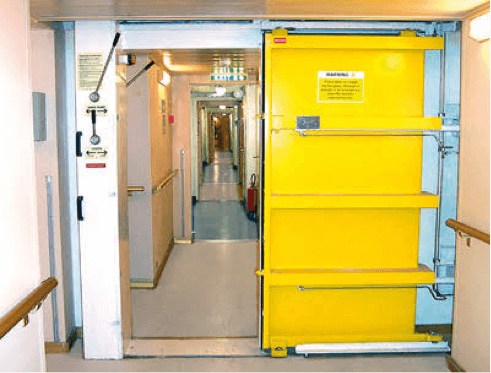

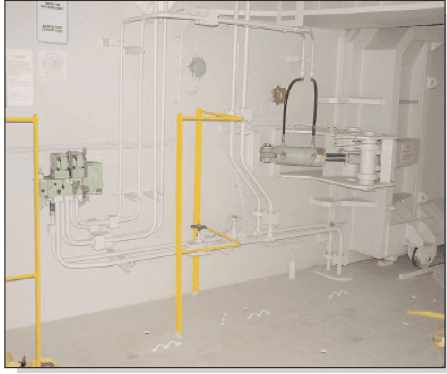

Some ship terms and definitions, though commonly famous in day-to-day life, are often misused on ships.
Gross Tonnage is the volume of all enclosed spaces on a ship. This includes the Engine Room and other non- cargo spaces as well. The tonnage is calculated by a complex formula that is not within this article’s scope. Most Maritime Regulations (SOLAS, MARPOL etc.) apply to ships based on their Gross Tonnage.
Net Tonnage, on the other hand, is the volume of only the cargo carrying spaces on the ship. This is the tonnage that determines the earning capability of the vessel. Most port/anchorage dues apply to ships based on their Net Tonnage.
Note:
The world’s waterbodies are divided into Oceans, Seas, Gulfs, Bays, Rivers, Estuaries, Lakes, Straits, Canals etc. Most of these are self-explanatory. However, most people fail to understand the difference between Gulf and Bay and Straits, Channels and Canals.
By definition, Gulf is a large waterbody which can sometimes be considered as an extended arm of a sea with a constricted entrance along a strait. A gulf is almost entirely enclosed by land.
E.g. the Persian Gulf, the Gulf of Mexico, the Gulf of Finland
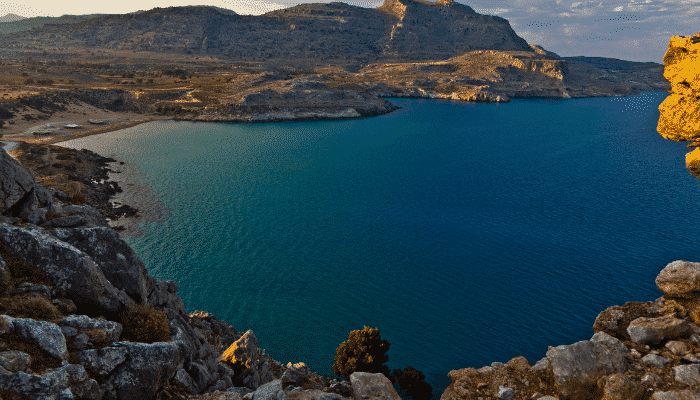

Bay is similar to a Gulf but generally smaller in size and has a wider entrance. However, there are exceptions to this definition. E.g. the Bay of Bengal is much larger than most of the bays of the world. Also, a Bay is not enclosed by land to a large extent.
E.g., the Bay of Biscay, Bay of Bengal.
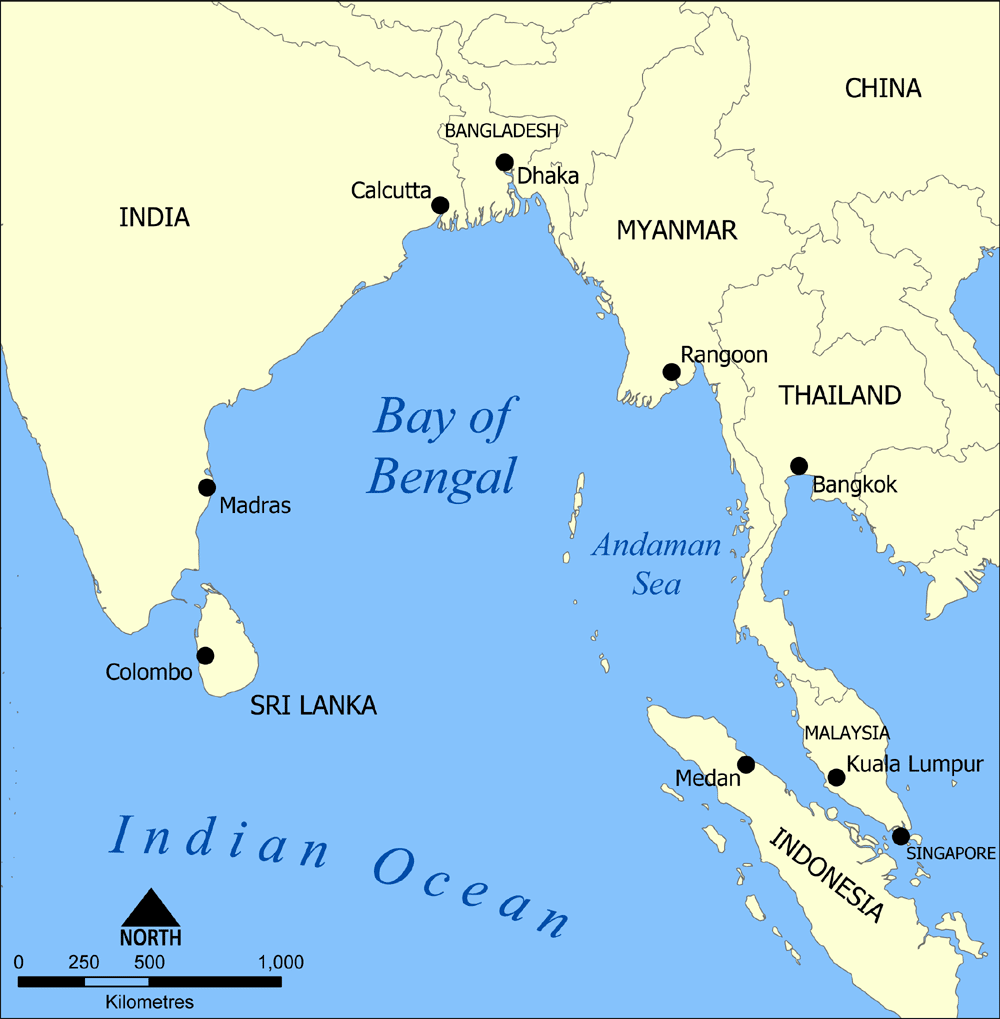

Strait is a narrow water-body interconnecting two much larger water bodies (Eg. Singapore and Malacca Straits connect the Bay of Bengal and the South China Sea). Water flow is in both directions and is tidal. Most importantly, straits are naturally formed without human intervention.
E.g. Singapore Straits, Sunda Straits, Lombok straits, Straits of Hormuz, Bosporus Straits, and Straits of Gibraltar.
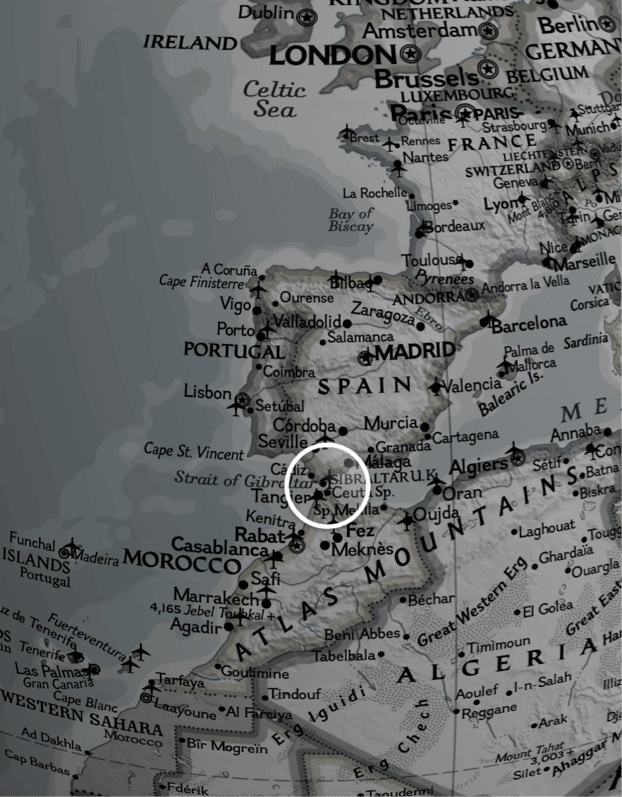

Channels can be defined as wider Straits. They have the same characteristics as the Straits, only that they are bigger and have more navigable water.
E.g. English Channel, Mozambique Channel,
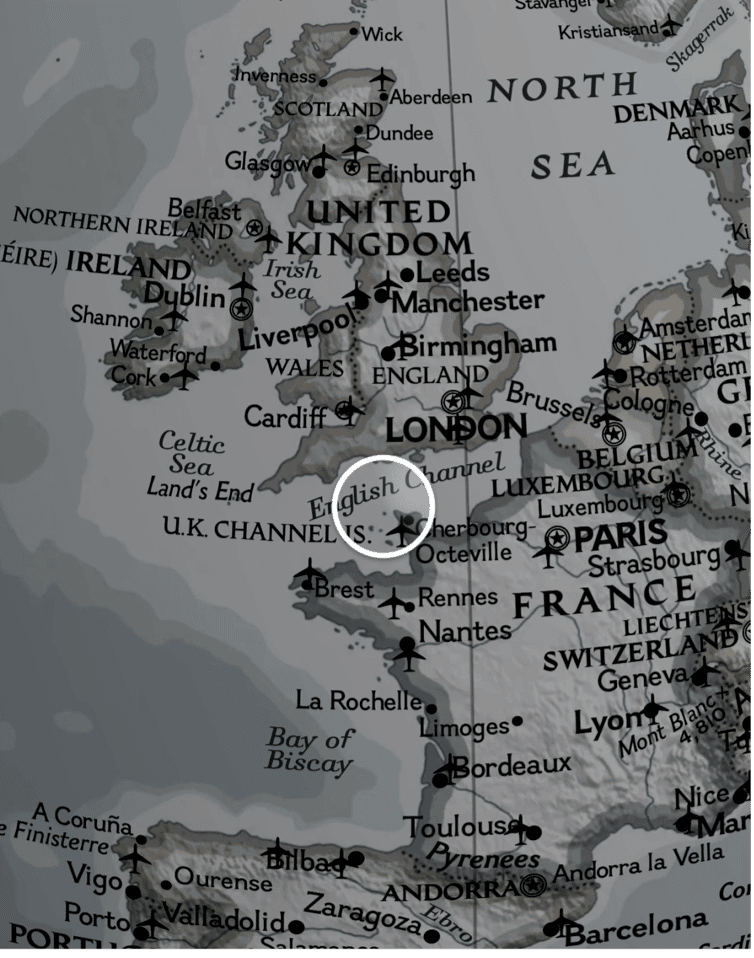

Canals are defined as man-made straits. It is an artificial waterway to facilitate trade between otherwise dangerous routes or cut short distances between natural routes.
E.g. Suez Canal, Panama Canal, Kiel Canal.
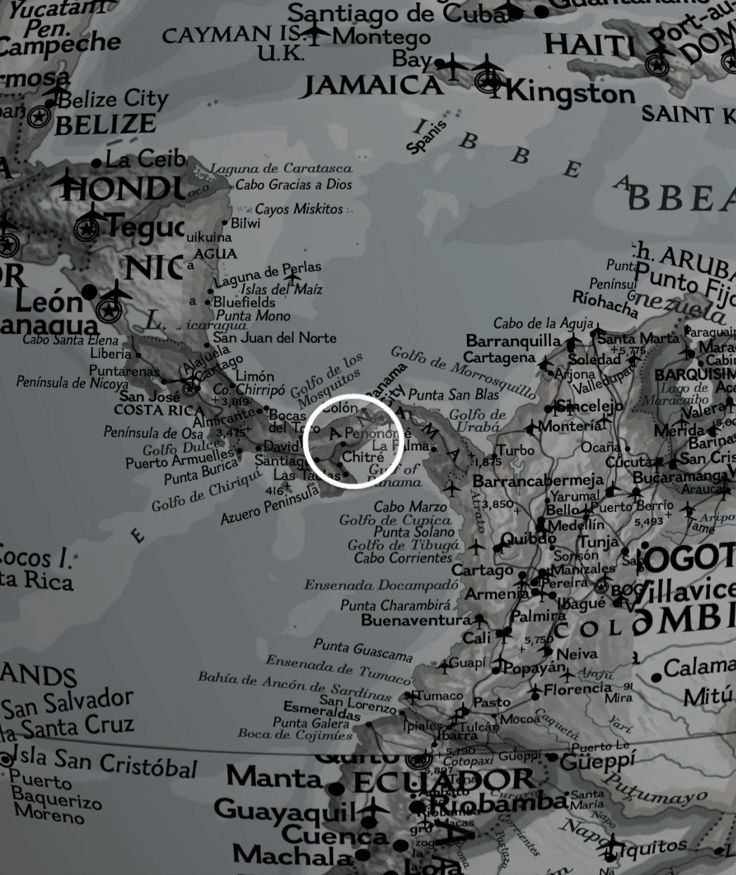

These ship terms are more to do with Tanker Officers and Crew.
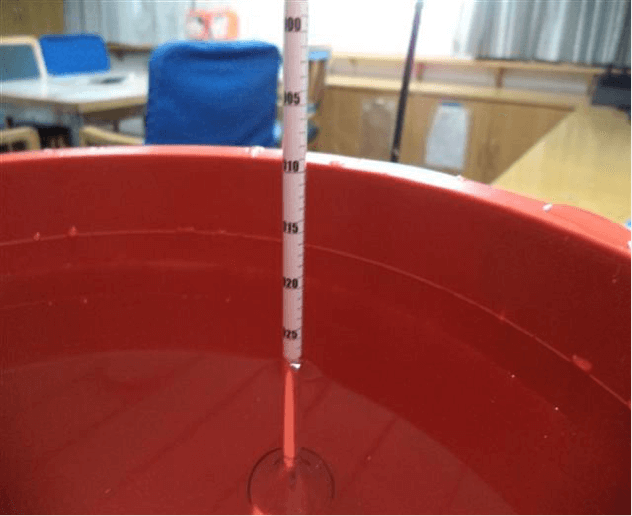

Density, by definition, is the amount of matter per unit of volume. Or, more simply, mass over volume. Hence it has units of kg/cm3.
E.g. the Density of Sea Water is approx. 1025 kg/m3
Specific Gravity is a ratio of the density of the substance divided by some reference material, typically Fresh Water. The units cancel each other out, often referred to as a ration.
For E.g. the Specific Gravity of Diesel Oil is 0.86
Density and Specific Gravity are the same if the reference material is Fresh Water since the Density of Fresh Water is 1.0 kg/cm3.
Fairleads, Chocks, Bitts, Bollards, Dolphins etc., are commonly used ship terms in mooring operations of vessels.
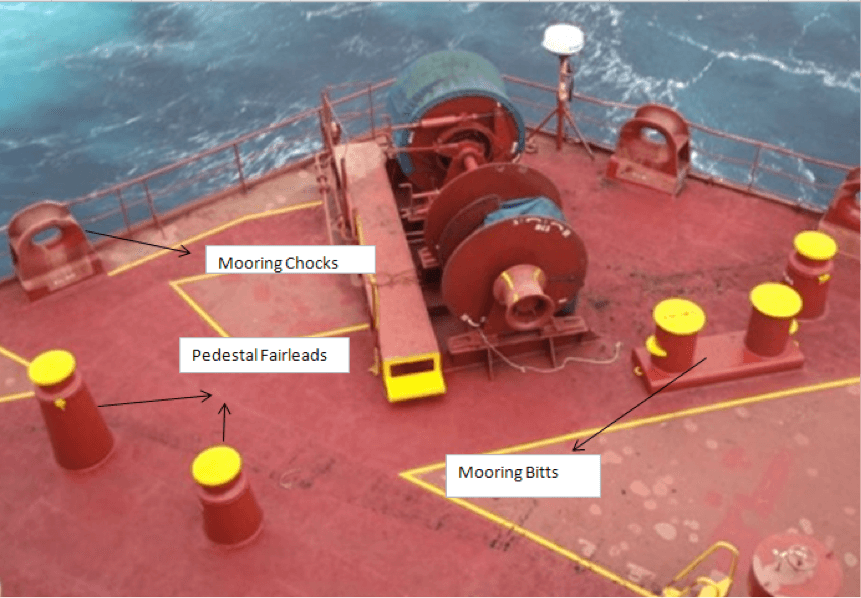

Fairleads: are welded directly onto the ship’s hull structure. Fairleads have a roller attached to them to guide mooring wires to winches for the correct lead. Pedestal Fairleads are commonly found on modern-day ships to guide mooring lines between the chock and the winch. Universal Fairleads have widely used ships earlier in lieu of chocks.
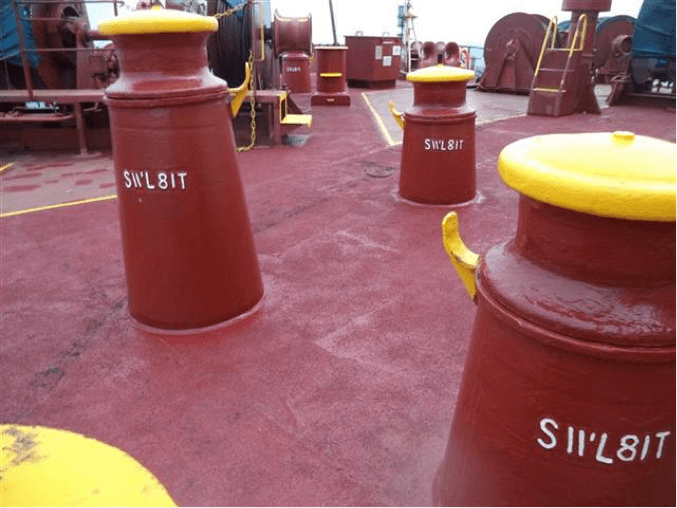

Chocks are structural reinforcements on ships which guide the mooring lines to and from the shore / other vessels. Chocks need to be much higher SWL than the mooring line to avoid structural damage and withstand various forces when a vessel is moored.
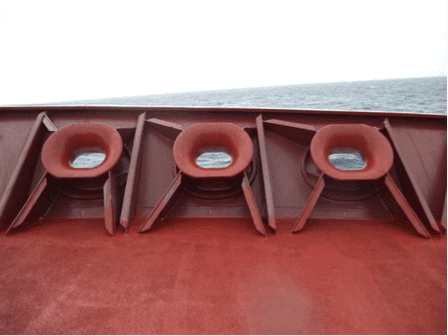

Bollards: are generally referred to as short posts on the quay/jetty used to secure Ship’s Mooring Lines. A single bitt on ships may also be referred to as a bollard around which the eye of the rope is attached. Oil Tankers have special bollards in the various areas called cruciform bollards, which are used for securing/supporting flexible hoses for cargo operations.
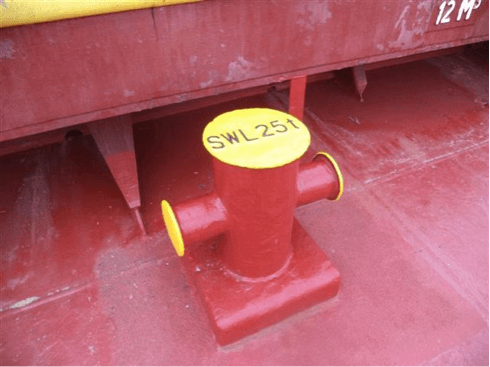

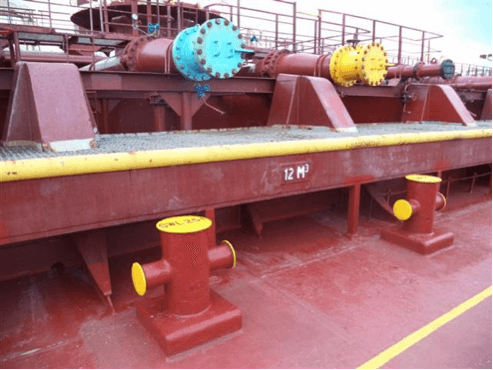

Bitts: are double bollards/posts mounted vertically on ships to secure mooring lines from other vessels (during STS operations), tug lines or secure Fire Wires on Tankers. Bitts are always found in pairs. It is important to inform the pilot or tug operator of the SWL of the bitts to ensure that the tug does not exceed this force when pulling the vessel.
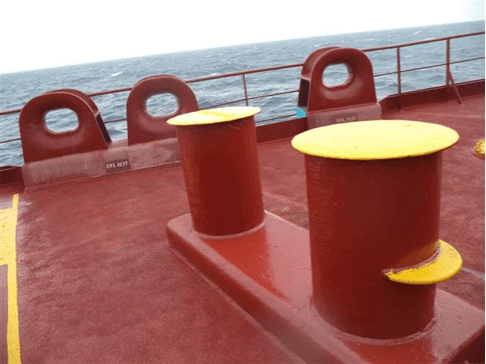

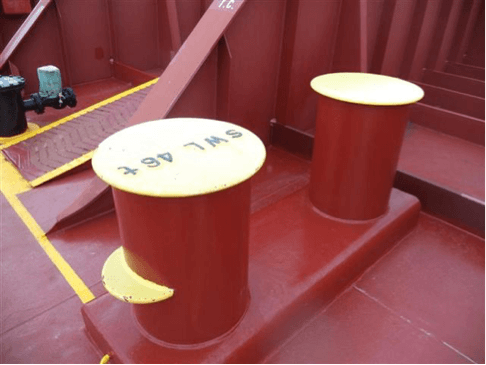

Dolphins: They are found only ashore. These are independent platforms on the jetty with hooks or bollards for securing the ship’s mooring lines.
Bilge: The lowest compartment of a ship or boat is called the bilge.
Derricks and Cranes are both ship terms related to lifting appliances. Derricks are now relics of the past and found only on a few older ships. They have been replaced by the more versatile and much simpler Deck Crane.
Derricks are lifting devices composed of one or more guy masts (supporting members). A derrick is controlled by several lines connected to the top of the mast, which controls the lateral and vertical motion of the derrick. The runner-up/down function to lift and lower a load is accomplished by a separate line similar to a crane.
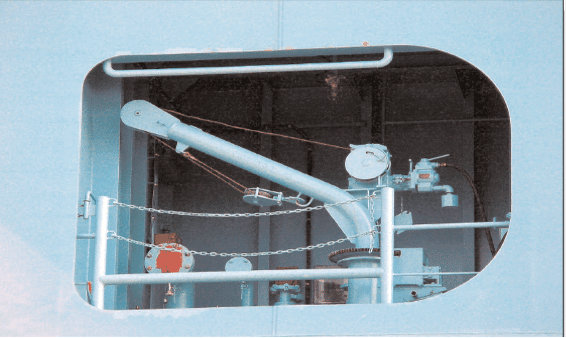

The most popular derrick on ships is the Union Purchase Rig, which uses two derricks, enabling the operators to load and discharge cargo much faster than single derricks.
One of the major disadvantages of the Derrick is that it takes longer to change the rig to suit different cargo types and lifts. The operation of derricks also requires at least two winch operators.
Cranes are similar to derricks but are much simpler in operation. A single crane driver accomplishes all functions – Runner up / down, Boom Up / Down, Swinging sidewards, etc. Most shipboard cranes are designed to swing through 360 degrees but may also have safety limit switches which prevent cranes from operating at angles which can cause damage to structures. Limit switches are also provided to prevent the runner wire from reaching the end of the drum.
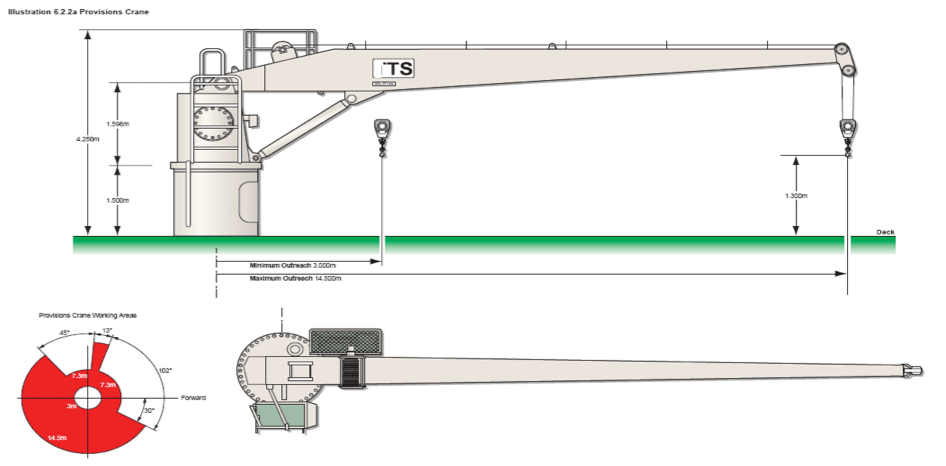

Swinging and Turning Circles – ship terms related to vessel navigation are often confused.
Swinging Circle is a shipping term used when the vessel is at anchor. This is the theoretical radius in which the ship is expected to swing at anchor. The radius of the swinging circle is generally calculated as (Number of Shackles x 27.5 m + Length of the Ship in meters). After anchoring, the watch officer (OOW) should ensure that the vessel remains within the Swinging Circle and that no other vessel anchors within the vessel’s swinging circle, plus some safety distance as decided by the Master. The swinging circle is not fixed and depends on the number of shackles paid out.
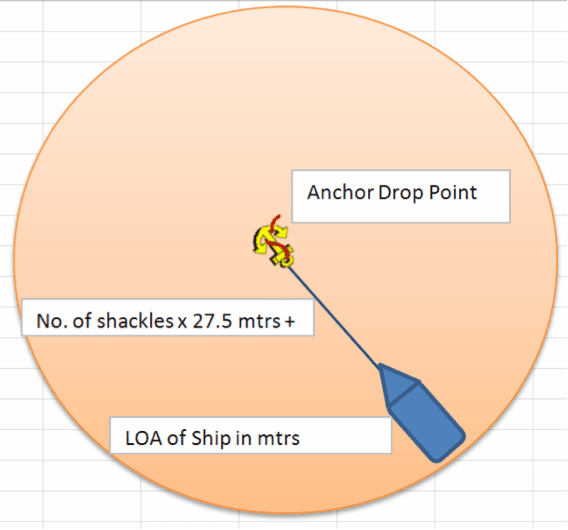

Turning Circle is part of the vessel’s manoeuvring characteristics. It is the diameter circumscribed by the vessel when the rudder is put hard over when going full ahead. This shipping term is generally determined during the vessel’s sea trials before delivery. The yard will provide details of the turning circles in Loaded and Ballast Conditions for shallow and deep waters. Turning circles are posted on the bridge and included in the Wheelhouse Poster, and one need not calculate the turning process each time and for different conditions.
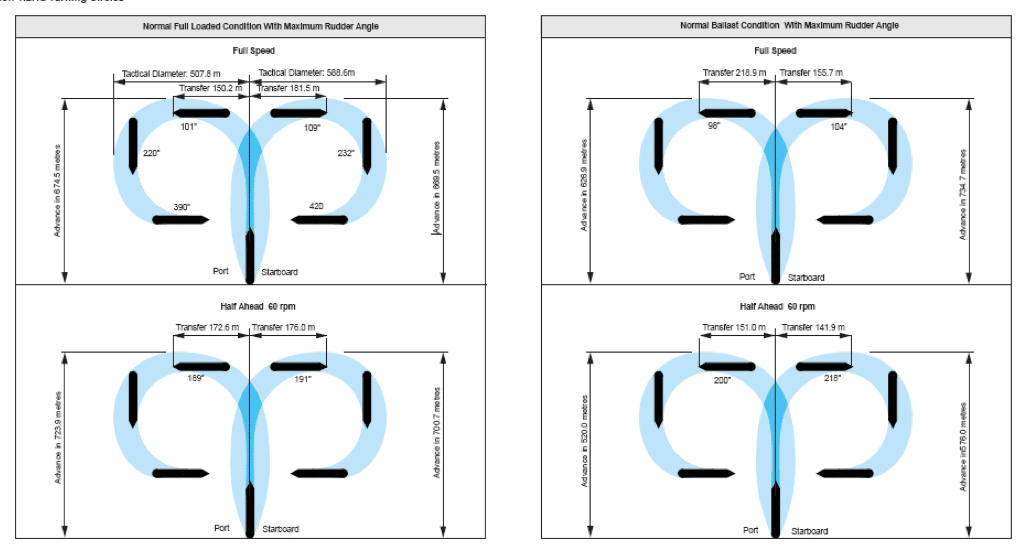

These are still the two most often interchanged ship terms used on vessels. Although, their purpose is the same. i.e. to serve as a link/bridge between the ship and the shore, their rigging and usage are different.
Gangways are rigged at right angles to the fore and aft line of the ship. Gangways should not be used at an angle of inclination greater than 30 degrees to the horizontal. Gangways are mandatory for ships over 30 meters in length. Gangways must only be rigged on railings that are reinforced for this purpose.


Accommodation Ladders are rigged in the fore and aft direction of the ship and face astern. The maximum angle of inclination from the horizontal shall not exceed 55 degrees. Accommodation ladders are generally fixed on the vessel and are swung out using dedicated winches and motors. These are mandatory for vessels over 120 meters in length.
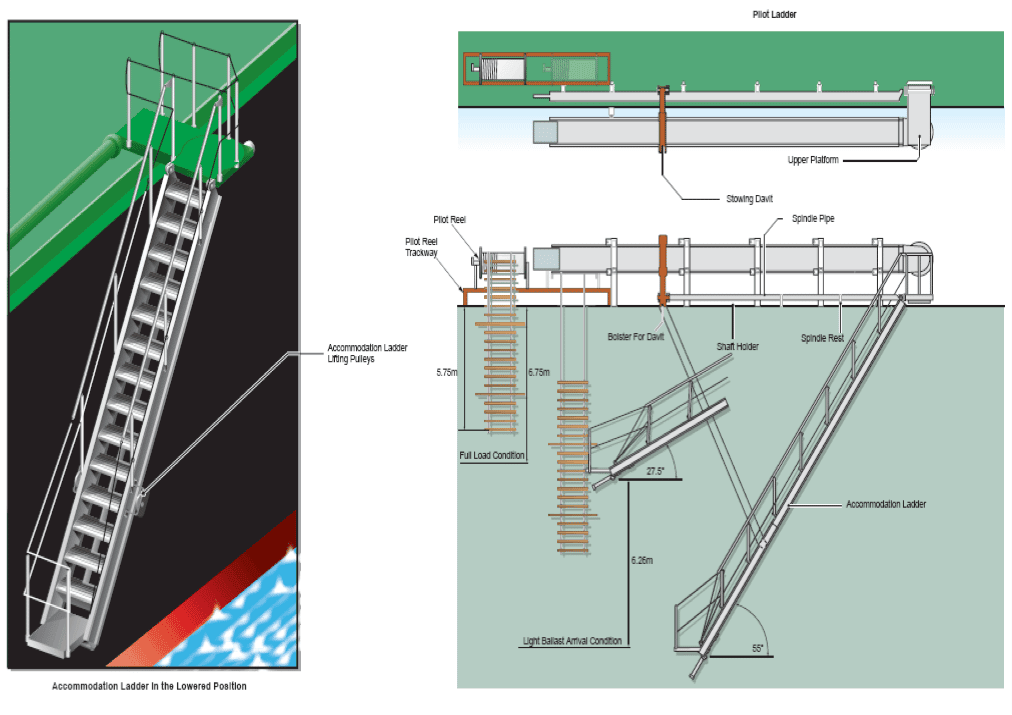

The above stand out as the most confusing among the myriads of ship terms and definitions. Let us look at what each one stands for.
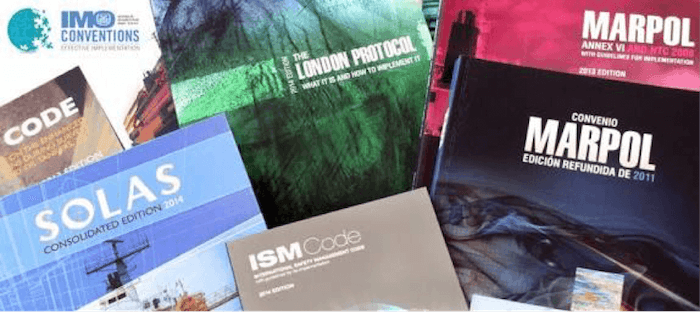

The convention is a formal treaty between signatory states to comply with various aspects governed by the agreement, which forms the basis of the treaty. IMO must first adopt conventions before member states can ratify them.
E.g. SOLAS Convention, MARPOL Convention, Loadline Convention, Maritime Labour Convention etc.
In merchant shipping, a Convention is binding on all member states only if it has formally been adopted by IMO and then ratified by member states. The rules for adopting conventions (tacit and active acceptance) are not in the scope of this article.
Protocol: A protocol is a supplementary treaty which modifies a Convention. It is a treaty that supplements or adds to a pre-existing convention. Instead of bringing out a new convention altogether, it is easier to enhance the convention using a protocol.
E.g. MARPOL 73/78 stands for The International Convention for the Prevention of Pollution from Ships which was formalised in 1973 and modified by the Protocol of 1978. The combined convention did not come into force until 1983 due to a lack of ratifications.
Code: A Code is part of a Convention and contains various technical details of essential aspects of the Convention. In other words, a code assists in elaborating the contents of the convention. It forms a part of a convention and cannot exist as a standalone regulation.
E.g., the ISPS Code (International Ship and Port Facility Security Code) is part of the SOLAS convention, and LSA and FSS Codes also form parts of the same conventions.
Annexe: An Annex is also a part of a convention which is introduced after the convention has been formalised. An annexe to a convention adopted by IMO has to be separately ratified by the member states to become legally binding on all member states.
E.g., MARPOL presently has six annexes, all of which have been ratified by member states at various intervals since the convention first came into force.
Ship terminologies are technical terms used by people in the shipping industry. Common terms include keel, tiller, starboard side, pier, hatch, dock, helm, valve, bow, beam, draft, freeboard, knots, nautical miles and so on.
The word does not mean a specific room onboard a vessel. Instead, it describes a safe distance from the shore or other hazards.
It acts as a stabilising tool which is thrown into the water. It is held at the seabed and acts as a brake. It keeps the hull in line with strong winds and perpendicular to the waves.
Galley refers to the kitchen area onboard a vessel, laid out longitudinally with overhead cabinets. A gangway is a narrow walkway or platform used for embarking or disembarking the vessel.
A toe rail is a boat fitting to prevent crew members from falling into the water. It serves a safety purpose and also has drain holes and pipes.
You might also like to read
Over to you.
Do you know some more commonly misunderstood and misused ship terms and definitions? Let us know in the comments below.
Disclaimer: The author’s views expressed in this article do not necessarily reflect the views of The Marine Learners. Data and charts, if used in the article, have been sourced from available information and have not been authenticated by any statutory authority. The author and The Marine Learners do not claim it to be accurate nor accept any responsibility for the same. The views constitute only the opinions and do not constitute any guidelines or recommendations on any course of action to be followed by the reader.
The article or images cannot be reproduced, copied, shared, or used in any form without the permission of the author and The Marine Learners.
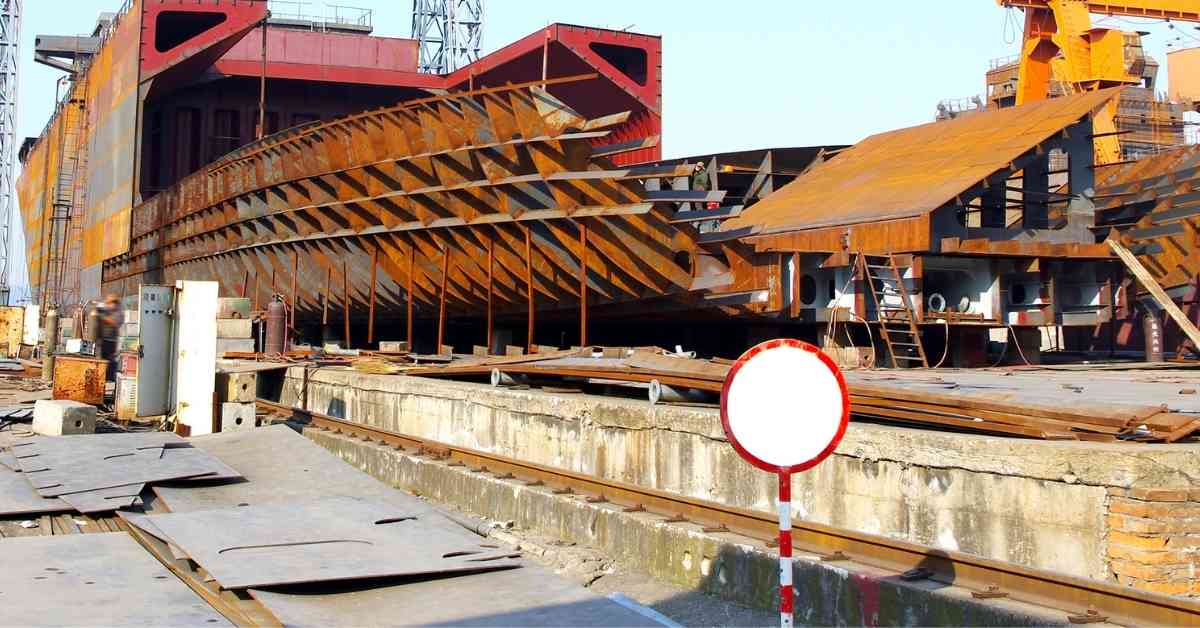

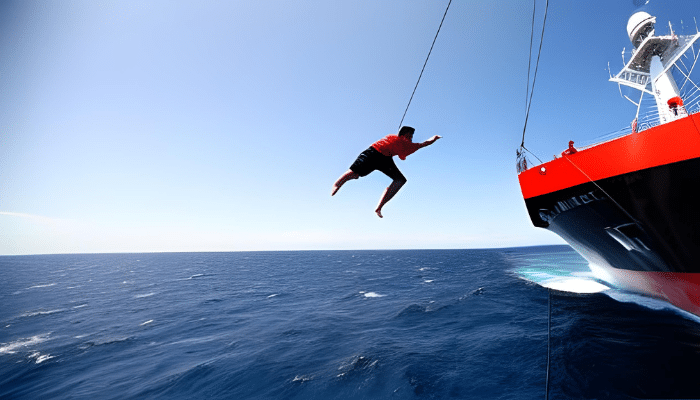

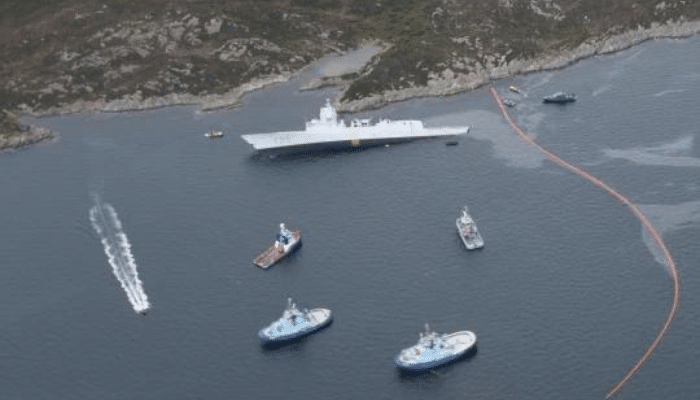

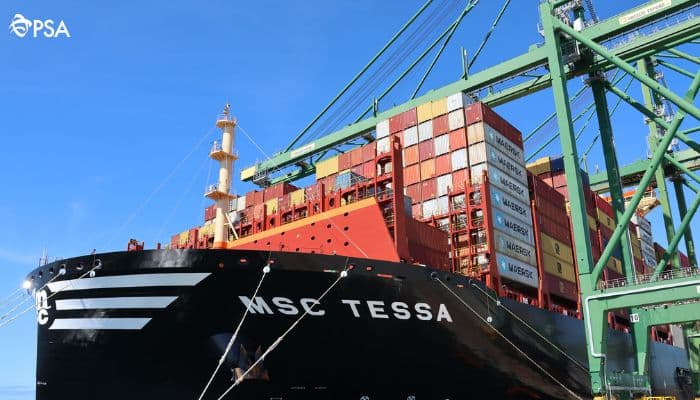

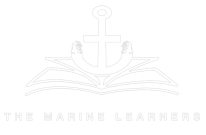

We believe that knowledge is power, and we’re committed to empowering our readers with the information and resources they need to succeed in the merchant navy industry.
Whether you’re looking for advice on career planning, news and analysis, or just want to connect with other aspiring merchant navy applicants, The Marine Learners is the place to be.